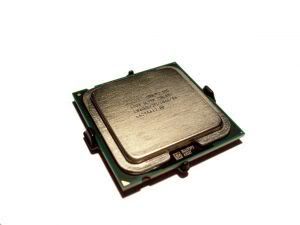But then, all that has changed with the introduction of the Core 2 Duo and the rest. It was when Intel decided to scrap the Netburst micro-architecture that never reached the potential that Intel believed was possible, and focused on the Pentium M architecture designed by their Israeli team that things started brightening up.

The architecture of the chip is simply known as Core, of which the products include Core 2 Duo and Core 2 Extreme. Both run on an 1066 MHz FSB bus and are built using 65nm transistors. Again, both are dual core chips, with the Core 2 Extreme coming with a higher cache and a higher clock speed. (There is also a workstation version of the Core architecture – Woodcrest Xeon.)
These processors are built on a 143 sq mm die and are made up of 291 million transistors, regardless of their L2 cache size. While rivals AMD use 90nm tranistors on their chips, Intel uses the 65nm ones.
Code named ‘Conroe’, Intel’s Core 2 Duo will have a mobile counterpart, named ‘Merom’.
Following are the various versions of the Core 2 Duo that are available.

Testing by PC World and others show that the Core 2 Duo processors are the fastest amongst the range considered for the desktop PCs. (Of course, we haven’t talked about the Quad Core ‘Kentsfield’ series from Intel – consisting of two Conroe chips.)
Apart from that, the Core 2 Duo series boasts of lower power consumption, resulting in lesser heat and higher performance.
Of course, the disadvantage is that you cannot use the processors on your existing motherboards as these processors - though they sit on the same Socket 775 interface as with the earlier Pentium 4 sockets – require different chipsets. Major manufacturers are ready with their motherboards which can use these Intel powerhouses, e.g. Gigabyte, ATI, nVIdia.
While it is difficult to say that whether investing in a Core 2 Duo motherboard makes sense in terms of longevity and it is known that the processor is incompatible with a lot of Pentium-compatible chipsets, it depends on the customer to make the call.


1 comment:
Informative read regards Intel Core 2 Duo Processor. The performance of this processor is really good because these processors are built on buildup on the latest technology.
Post a Comment